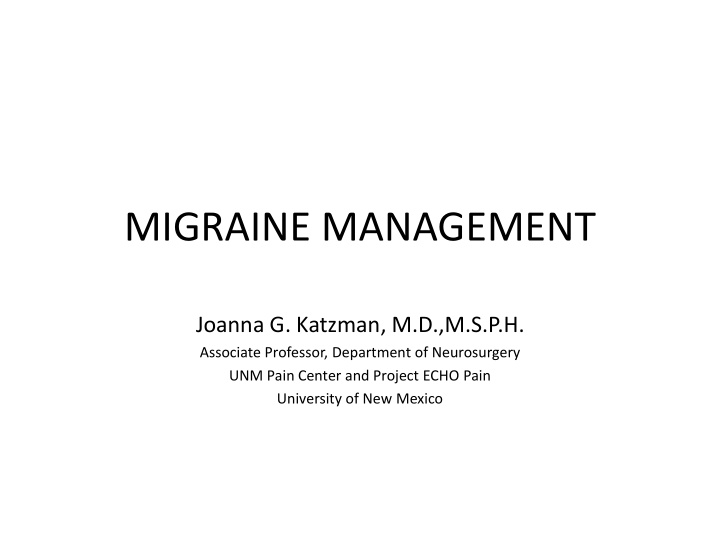



MIGRAINE MANAGEMENT Joanna G. Katzman, M.D.,M.S.P.H. Associate Professor, Department of Neurosurgery UNM Pain Center and Project ECHO Pain University of New Mexico
Disclosure • The presenter has no financial relationship to this program.
Objectives 1. The trigeminovascular theory of migraine etiology 2. Presenting signs and symptoms of migraine 3. The most common medications for prevention, abortive and rescue treatment
Outline • Migraine throughout the decades • Trigeminovascular theory • Abortive treatment of migraine • Prophylactic treatment of migraine • Menstrual migraine • Complicated migraine • Medication overuse • Rescue therapy
Early Classification of Migraine • Common Migraine (without visual aura) – nausea, vomiting, photophobia • Classical Migraine (with visual aura) – ex. scintillating scotoma thought to represent neuronal spreading neuronal spreading depression • Basilar Artery Migraine - ER Bikerstaff • Migraines in Children - Bo Bille
1990s ---Decade of the Triptans • 7 “ triptan ” medications marketed in U.S. for abortive treatment • Valproate FDA approved for migraine prophylaxis in U.S. • Gababentin and Topiramate Open-label and double blinded trials for migraine prevention — positive • Phase-Specific Treatment of Migraines
PHASE-SPECIFIC TREATMENT OF MIGRAINE
MIGRAINE PATHOPHYSIOLOGY Pain Syndrome Trigeminal nucleus activated Calcitonin gene – related peptide (CGRP) released by trigeminal nerve CGRP release causes vasodilation Plasma protein extravasation causes sterile inflammation in the dura matter
The Trigeminovascular Theory Adapted from Lancet 1998;351:1045
ABORTIVE TREATMENT OF MIGRAINE Selective 5- HT 1B/1D, receptor agonists (“ Triptans ”) – Sumatriptan (Imitrex) – Rizatriptan (Maxalt) – Zolmitriptan (Zomig) – Naratriptan (Amerge) – Almotriptan (Axert) – Frovatriptan (Frova) – Eletriptan (Relpax)
Selected Triptan Comparison Table Eletriptan Sumatriptan Rizatriptan Frovatriptan (Relpax) (Imitrex) (Maxalt) (Frova) Bioavailability 50% 15% 45% 20-30% Tmax 1.5 hrs 2.5 hrs 1.5 hrs 2-4 hrs Half-Life 4 hrs 2.5 hrs 2-3 hrs 26 hrs Efficacy at 2 hrs 45-64% 46-62% 60-70% 37-46% Usual Dosage 20-40 mg 25-50 mg 5-10 mg 2.5 mg
Triptan Medication Warning • History of Cardiovascular Disease • Uncontrolled Hypertension • Complicated Migraine • Age greater than 65 • Pregnancy • Frequent use of other serotonergic medications
ADDITIONAL ABORTIVE TREATMENTS OF MIGRAINE Non-selective serotonin agonists – Dihydroergomtamine – Ergotamine Barbiturate-containing compounds – Fiorinal/Fioricet Non-Steroidal anti-inflammatory drugs – Naproxen Sodium
Drugs Approved by FDA for Migraine Prophylaxis Methysergide maleate 1962 Propanolol 1979 Timolol 1990 Divalproex sodium 1996 Delayed-release tablets Divalproex sodium 2000 Extended-release tablets Topiramate 2004
OTHER PROPHYLACTIC MEDICATIONS • Tricyclic Antidepressants Controlled trials showing benefits of amitriptyline in migraine, tension, posttraumatic and mixed headaches • Calcium Antagonists Modest benefits of verapamil and flunarizine in double-blind placebo controlled studies
MIGRAINE PREVENTION AND NEUROPATHIC AGENTS Mechanisms of Action Anti-epileptic medications may prevent the release of vasoactive neuropeptides from the trigeminal sensory nerve • CGRP (Calcitonin gene-related peptide) • Neurokinin A • Substance P
MENSTRUAL MIGRAINE Introduction • Link between estrogen and progesterone and migraines in women • No gender difference with migraine in prepubertal children • Migraine significantly more common in adult women than in men • Peak incidence of migraine during adolescence (for women) and in second decade (for men)
MENSTRUALLY ASSOCIATED MIGRAINE • 10% of women with any kind of migraine have onset of migraine headaches at menarche • 33% of women with menstrual migraine have onset at menarche • 3 Types of menstrually associated migraine: 1. Menstrual Migraine (MM) 2. True Menstrual Migraine (TMM) 3. Pre-Menstrual Migraine (PMM)
EXOGENOUS ESTRADIOL DELAYS ONSET OF MIGRAINE
ADVANCES IN MENSTRUAL MIGRAINE MANAGEMENT Abortive Treatments • Zolmitriptan – first large prospective double blind trial comparing zolmitriptan to placebo in a population of women with menstrual migraine • Most triptans now used for hormonally mediated migraines Preventive Treatments • Estrogen replacement (Transdermal Estradiol) • NSAIDS (Mefenamic acid)
COMPLICATED MIGRAINE • Involves significant neurological deficits • Recovery may take hours to days • Rarely may represent a stroke • Treatment should NOT include ergotamines or “ Triptans ” • Treatments include Valproate, Verapamil and aspirin • Oral contraceptive use contraindicated
MEDICATION OVERUSE Analgesic-rebound headache • Opiates • Caffeine-containing combination analgesics Triptan medication overuse Treatment includes taper off offending agent(s) and placement on daily prophylaxis
THE ROLE OF RESCUE MEDICATIONS • What are Rescue Medications? • When are they used? • Who needs to be “rescued”?
CRITERIA FOR PRESCRIBING OPIOID MEDICATIONS FOR MIGRAINE SUFFERS 1. The patient reports identical previous migraine headaches, and 2. During the migraine, the sufferer is in moderate to severe distress, and 3. The patient has no history of substance abuse, and 4. At least one of the following should apply: – In the past, the patient consistently has not obtained relief from the 5-HT 1B/1D agents (ie triptans and ergots) – In the past, the patient has consistently not obtained relief from the non- opioid agents. – The patient has used the maximum amounts of his/her usual abortive agents (eg triptans, NSAIDs) and the headache persists or recurs (see Table1). – The usual migraine abortive agents (NSAIDs or 5-HT 1B/1D ) are contraindicated (see Table 1).
Recommend
More recommend